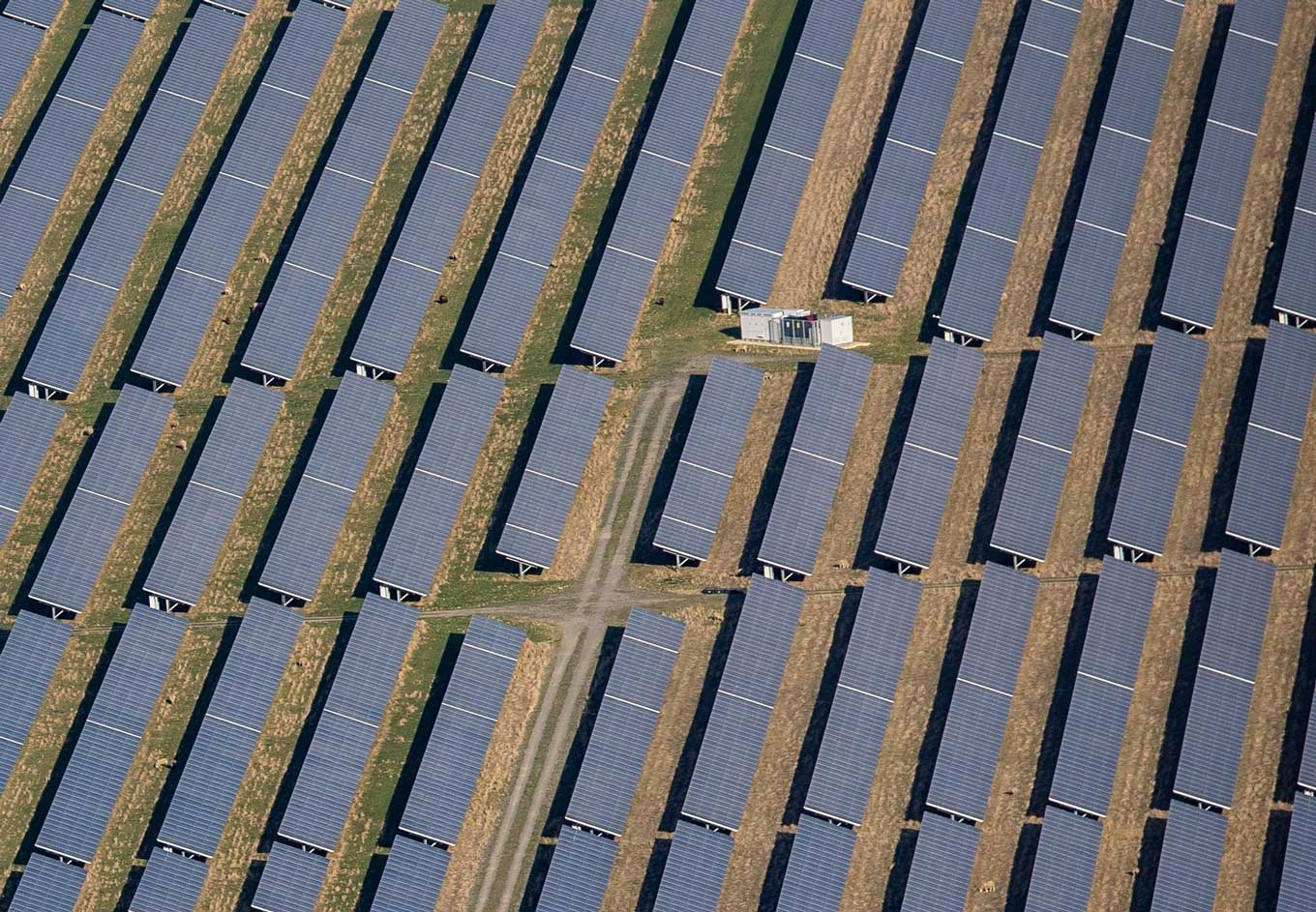How Solar Tracker Design Software and Grading Optimization Work Together Through Design Automation

Balancing Grading and Tracker Tradeoffs Through Design Automation
Yet, despite its importance, grading remains one of the most complex and misunderstood components of photovoltaic (PV) system design. That is why fast growing solar businesses are increasingly turning to solar grading optimization software - advanced tools that use real-world data, simulation, and proprietary algorithms to strike the perfect balance between earthworks, energy yield and cost efficiency.
At PVFARM, we’ve built a platform that goes beyond traditional solar design software. By integrating civil, electrical, and energy analysis into one real-time environment, we help developers, engineers and EPCs design more efficiently, minimize earthwork costs, and unlock new levels of performance and profitability.
The Hidden Cost of Poor Grading Decisions
In traditional solar farm design, grading is often treated as a late-stage engineering step; something handled after layout and energy modeling are already complete. But this reactive approach can have serious financial consequences.
Poorly optimized grading can:
- Increase cut-and-fill volumes by up to 40%, dramatically raising construction costs.
- Lead to excess steel quantities on site.
- Lead to suboptimal tracker placement and self-shading, reducing system performance and long-term energy yield.
- Create drainage or erosion issues that require costly remediation.
According to the National Renewable Energy Laboratory (NREL), civil construction - including grading and site preparation - can account for up to 20% of total utility-scale solar project costs. Reducing these expenses through smarter design, therefore, directly impacts project ROI, making grading optimization one of the most powerful levers in solar engineering.
Why Grading Optimization Matters More Than Ever
The solar industry is evolving rapidly. As developers pursue larger, more complex sites - from undulating farmland to reclaimed industrial areas - grading challenges are multiplying.
At the same time, solar tracker design software and solar grading optimization software are converging to deliver new capabilities. With real-time data analysis and terrain-following algorithms, modern platforms, such as PVFARM, can evaluate multiple site scenarios in minutes, helping design teams make faster, more informed decisions.
Balancing Terrain, Technology and Efficiency in Modern Solar Projects
This shift isn’t just about cutting earthwork costs. Smarter grading optimization also improves:
- Energy production, by ensuring panels maintain optimal tilt and azimuth across varying terrain.
- Environmental impact, by reducing soil disturbance and preserving natural drainage.
- Installation efficiency, by simplifying construction workflows and pile placement.
- Cost and risk management, by minimizing rework, reducing material movement, and preventing design or construction errors that drive up expenses.
In short, effective grading isn’t just a technical detail; it is a cornerstone of sustainable and cost-effective solar development.
The Limitations of Conventional Tools
Historically, grading analysis has been performed using generic CAD software or civil engineering tools not built for solar. These tools can calculate slopes and volumes, but they don’t integrate with energy modeling or tracker configurations; leaving engineers to juggle multiple systems and make assumptions about performance impacts.
In most cases, this siloed workflow means:
- Manual data transfer between platforms (CAD, PVSyst, GIS).
- Limited ability to assess the impact of grading decisions on DC/AC performance.
- No real-time feedback when terrain or design parameters change.
Transparency in Solar Design Software Drives Better Results
While many solar design tools offer partial automation, they often function as “closed systems,” producing outputs without revealing the assumptions behind them. This lack of transparency limits engineers’ ability to customize designs, reduces flexibility, and ultimately, undermines confidence in the accuracy and reliability of the final results.
PVFARM was meticulously designed to solve these complex scenarios at their source, and close the gaps left by conventional tools to ensure precision at every stage of solar design.

PVFARM: A New Standard in Solar Grading Optimization
At PVFARM, we approach grading as a critical design component that directly shapes project performance and profitability. Our solar grading optimization software is seamlessly integrated within a multidisciplinary design platform, combining civil, electrical and energy modeling in real time to deliver precise, data-driven results.
Here’s how it works:
1. Real-Time Terrain Analysis
PVFARM’s proprietary algorithms process detailed elevation data (DEM, LiDAR, or survey-based) to model true topography. The system identifies slope constraints, cut-and-fill volumes, and natural water flow paths within seconds - allowing engineers to visualize and plan grading with unmatched precision.
2. Terrain-Following Tracker Design
Traditional trackers require flat or uniformly graded surfaces, which can lead to excessive earthworks. PVFARM incorporates advanced solar tracker design capabilities, supporting terrain-following layouts that adapt to site conditions while maintaining energy alignment and mechanical integrity.
3. Energy-Cost Trade-Off Modeling
Our software doesn’t just minimize earthworks; it quantifies how grading decisions affect performance. For example, reducing slope variation may slightly increase energy yield but dramatically raise civil costs. PVFARM allows users to compare multiple grading and tracker configurations side by side, identifying the optimal balance between cost and performance.
4. Advanced Cut-and-Fill Optimization
Using 3D modeling and slope constraints, PVFARM automatically adjusts grading strategies to minimize material movement. This precision engineering reduces fuel use, haul distance, and heavy machinery time - delivering both environmental and financial benefits.
5. Scalable, Cloud-Based Performance
Whether you’re modeling a 5 MW commercial project or a 1 GW utility-scale system, PVFARM’s architecture scales effortlessly. The platform processes large datasets quickly, maintaining speed and accuracy even on multi-gigawatt designs.
The Benefits of PVFARM for Developers and EPCs
Integrating grading optimization into the early design process gives project teams measurable advantages across multiple stages of development. This includes:
✅ Faster Design Turnaround
Automation within PVFARM’s integrated platform has been shown to reduce design time by up to 90%, allowing engineers to focus on innovation rather than repetitive iterations.
✅ Reduced Construction Costs
Optimized grading minimizes earthwork volumes, translating directly into lower equipment, labor, and fuel expenses - often saving millions on large projects.
✅ Improved Energy Performance
Accurate topography modeling allows panels and trackers to maintain ideal orientation, boosting overall energy output.
✅ Lower Environmental Impact
Less earth movement means reduced soil disturbance, erosion, and carbon emissions - aligning with sustainability goals and permitting requirements.
✅ Greater Stakeholder Confidence
Clients, investors, and regulators all benefit from transparent, data-backed design decisions that reduce risk and increase project bankability.
PVFARM vs. Conventional Solar Design Software
While other solar design software solutions and tools focus primarily on electrical layouts or energy simulations, PVFARM integrates all aspects of solar farm engineering into a single environment.
Feature
Conventional Tools
PVFARM
Grading Analysis
Manual, post-layout
Integrated and real-time
Energy Modeling
Separate tool required
Built-in and dynamic
Civil-Electrical Coordination
Siloed
Fully unified
Tracker Optimization
Limited
Terrain-following support
Scalability
Slows beyond 200 MW
Proven at 1 GW+
Transparency
Fixed outputs
Full visibility and control
This unified approach enables solar companies to streamline workflows, reduce rework and utlimately, deliver exceptional solar projects with both speed and confidence.
From Complexity to Clarity
Grading optimization has traditionally been one of the most time-consuming and uncertain aspects of solar farm design. With PVFARM, that complexity becomes clarity. Our software empowers engineers to test multiple grading strategies, compare outcomes, and make informed decisions - all within a single interface.
Whether you’re developing a hillside solar installation or planning multi-gigawatt solar systems across variable terrain, PVFARM gives you the analytical power and design precision to move from feasibility to execution faster.
Real-World Example: Smarter Designs, More Efficiency
In one recent project, EDF Power Solutions used PVFARM to evaluate ten layout scenarios on a complex site with oil-wells and variable terrain. The platform enabled their team to compare tracker types, grading strategies and MV cable configurations in real time - streamlining decision-making and avoiding engineering bottlenecks.
In another example, NARENCO, a leading U.S. independent power producer (IPP), used PVFARM to cut estimating time by 50% and achieve a fivefold return on investment within just six months. By replacing multiple manual systems with PVFARM’s rapid terrain and electrical modeling tools, NARENCO’s team was able to deliver accurate, data-driven solar proposals in days instead of weeks.
The outcome? Significant savings in civil construction, accelerated installation timelines, and a more sustainable project footprint - all made possible through data-driven insight and smarter design.

Future-Proofing Solar Development
As the solar industry expands into more diverse and challenging landscapes, grading optimization will become even more vital. Terrain-following trackers, bifacial modules, and high-density PV systems demand design precision that only integrated software can deliver.
PVFARM’s integrated solar design platform - including advanced grading optimization and tracker design capabilities - represents the next evolution in utility-scale solar engineering. It enables developers, EPCs, and engineers to plan with precision, scale with confidence, and deliver cleaner, more cost-effective solar energy worldwide.
Powering the Future of Solar Design
In an industry defined by innovation, efficiency and environmental responsibility, the ability to optimize grading strategies is no longer optional - it is essential.
PVFARM’s mission is to provide solar professionals with tools that enable smarter decisions, faster workflows and better outcomes. Our integrated design platform helps teams plan, analyze and build solar projects that deliver exceptional performance and unmatched reliability at every scale.
See PVFARM in Action
Ready to see how PVFARM can transform your next project?
Book a demo or contact our team today to learn how our integrated solar design platform can help you streamline workflows, reduce costs and deliver more efficient, sustainable solar farms.


%20(1).png)


.png)
